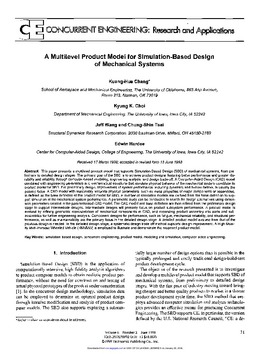| dc.contributor.author | Kuang-Hua Chang | |
| dc.contributor.author | Kyung K. Choi | |
| dc.contributor.author | Jeff Wang | |
| dc.contributor.author | Chung-Shin Tsai | |
| dc.contributor.author | Edwin Hardee | |
| dc.date.accessioned | 2016-01-14T19:53:25Z | |
| dc.date.accessioned | 2016-03-30T15:34:13Z | |
| dc.date.available | 2016-01-14T19:53:25Z | |
| dc.date.available | 2016-03-30T15:34:13Z | |
| dc.date.issued | 1998-06-01 | |
| dc.identifier.citation | Chang, K.-H., Choi, K. K., Wang, J., Tsai, C.-S., & Hardee, E. (1998). A Multilevel Product Model for Simulation-Based Design of Mechanical Systems. Concurrent Engineering, 6(2), 131-144. doi: 10.1177/1063293x9800600204 | en_US |
| dc.identifier.uri | https://hdl.handle.net/11244/25244 | |
| dc.description.abstract | This paper presents a multilevel product model that supports Simulation-Based Design (SBD) of mechanical systems, from pre liminary to detailed design stages The pnmary goal of the SBD is to achieve product designs featuring better performance and greater du rability and reliability through computer-based modeling, engineering analysis, and design trade-off. A Computer-Aided Design (CAD) model combined with engineering parameters and mathematical equations that simulate physical behavior of the mechanical system constitute its product model for SBD. For preliminary design, improvement of system performance, including dynamics and human factors, is usually the primary focus A CAD model with reasonably accurate physical parameters, such as mass properties of major components or assemblies, is defined as the base definition of the product model for SBD. A number of simulation models are derived from the base definition to sup port simulation of the mechanical system performance A parametric study can be conducted to search for design alternatives using dimen sion parameters created in the parameterized CAD model. The CAD model and base definition are then refined from the preliminary design stage to support intermediate designs. Intermediate designs will primarily focus on product subsystem performance. A product model is evolved by refining geometric representation of mechanical components in CAD, and expanding product assembly into parts and sub assemblies for further engineering analysis Component designs for performance, such as fatigue, mechanical reliability, and structural per formance, as well as maintainability are the primary focus in the detailed design stage. A detailed product model evolved from that of the previous design is needed In the detailed design stage, a systematic design trade-off method supports design improvement. A High Mobil ity Multi-Purpose Wheeled Vehicle (HMMWV) is employed to illustrate and demonstrate the proposed product model. | en_US |
| dc.language.iso | en_US | en_US |
| dc.publisher | Concurrent Engineering | |
| dc.subject | simulation-based design | en_US |
| dc.subject | concurrent engineering | en_US |
| dc.subject | product model | en_US |
| dc.subject | modeling and simulation | en_US |
| dc.subject | computer-aided engineering. | en_US |
| dc.title | A Multilevel Product Model for Simulation-Based Design of Mechanical Systems | en_US |
| dc.type | Research Article | en_US |
| dc.description.peerreview | Yes | en_US |
| dc.description.peerreviewnotes | https://us.sagepub.com/en-us/nam/manuscript-submission-guidelines | en_US |
| dc.identifier.doi | 10.1177/1063293x9800600204 | en_US |
| dc.rights.requestable | false | en_US |
